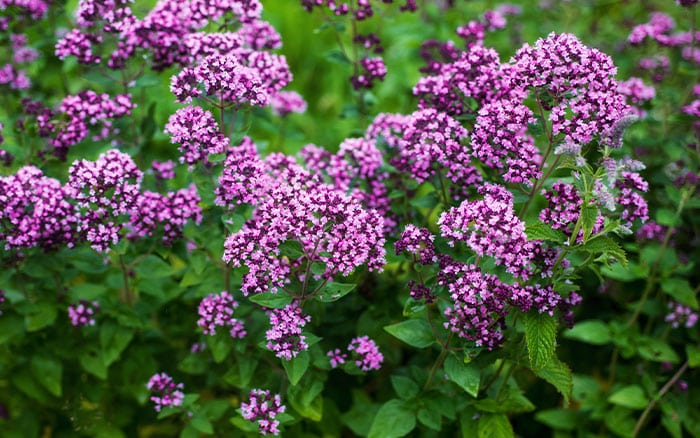Marjoram is a lovely flowering herb in the mint family. Its distinctive aroma is similar to oregano with a slightly sweeter taste, which makes a wonderful and delicate feature in the garden.
Plant Biography

What is the botanical name for Marjoram?
Origanum majorana
What are the common names for Marjoram?
Marjoram
Where are Marjoram native to?
It is mostly native to the Mediterranean, and has naturalised in many parts of the world including southern Europe.
What does it look like?
Closely related and similar looking to Oregano, Marjoram is a perennial, evergreen, edible herb. It has small, rounded leaves and white or purple flowers. It is often used to season chicken and tomato dishes and is generally sweeter than Oregano.
What colours does it come in?
White and purple.


What growing conditions are best for Marjoram?
Marjoram thrives when grown in an open, sunny aspect, in free-draining alkaline soil, ideally with a neutral pH, but will cope with lower and higher soil pH levels.
Marjoram will not grow well in badly drained, heavy soil.
How to grow Marjoram
- Plant in well-drained soil in an open, sunny aspect in late spring or summer after all risk of frost has passed.
- Leave a 25cm space between other plants as it will form a spreading clump once established.
- To overcome less than ideal growing conditions, plant in containers filled with a mix of peat free and soil-based compost mixed with horticultural grit.
- Prune in spring to keep the plant’s size in check and to prevent it become straggly.
Do pollinators like Marjoram?
The flowers attract both bees and butterflies, and can be quite a big hit amongst these pollinators.

Which Marjoram variety should you grow?
All varieties grow to a similar size and have similar growing condition requirements. So choose one which you like the appearance of the most, or a mixture of different varieties to suit your design.
How big will it get?
Once established, this plant can reach heights of up to 60cm tall, and can spread to between 20 and 30cm.

How to plant Marjoram successfully
Plant in well-prepared free-draining soil with the base of the plant’s stem level with the soil surface.
How to care for it and keep it look good
Ensure the plant has a regular water supply to induce better flavoured leaves.
Cut flowered stems back in late spring or early summer to stimulate new, lush growth.
How to propagate Marjoram
It can be sown from seed but, as it readily self-seeds, dividing established plants in spring is a quicker way of creating instant impact plants with established leaves and root systems.
Other ways to propagate are by taking stem cuttings and/or layering stems in soil in early summer.
How to problems can they have?
Aphids, cutworms, spider mites, thrips, and mint rust.
Varieties of Marjoram to consider
Origanum x majoricum (Italian Marjoram)
Has small, soft, aromatic, pale green leaves well suited to tomato and pizza dishes.
Origanum majorana (Sweet Marjoram)
Is one of the sweetest flavoured.
Origanum majorana var. tenuifolium ‘Weston’, (Cypriot Marjoram)
Native to Cyprus, the tiny, white, tubular flowers grow around its green centre in a knot shape.
When is the best time to buy Marjoram?
Spring and summer is the best time to buy young and established plants from Garden Centres and Plant Nurseries. A greater range of cultivars can usually be obtained from specialist herb nurseries.

Which garden styles are best for Marjoram?
This plant is well suited to mediterranean and cottage garden schemes as well as herb gardens.

Leave A Comment